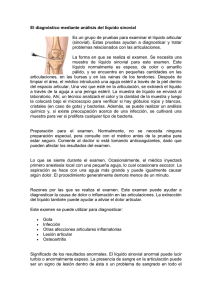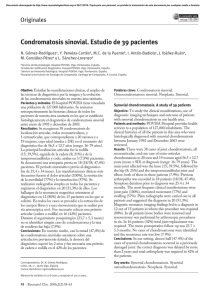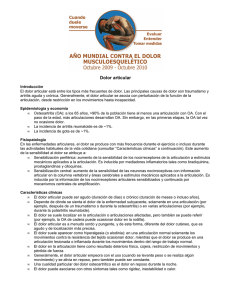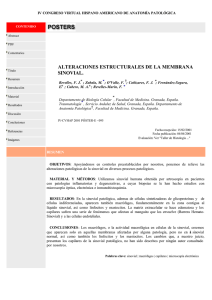Condromatosis sinovial de la articulación temporomandibular
Anuncio
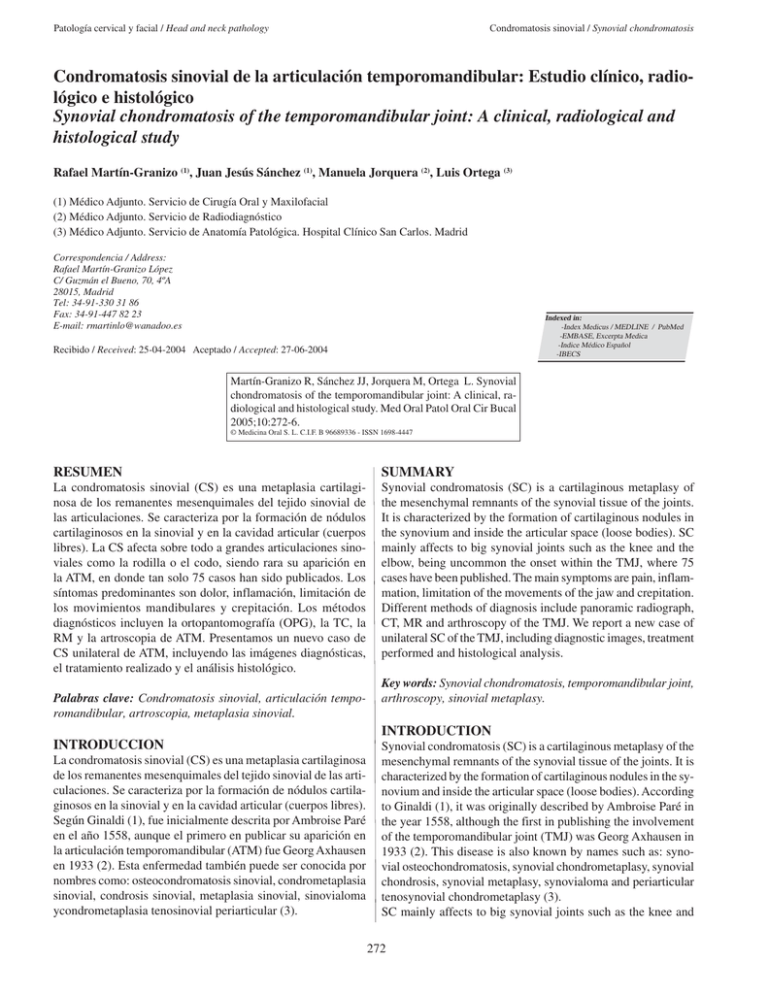
Patología cervical y facial / Head and neck pathology Condromatosis sinovial / Synovial chondromatosis Condromatosis sinovial de la articulación temporomandibular: Estudio clínico, radiológico e histológico Synovial chondromatosis of the temporomandibular joint: A clinical, radiological and histological study Rafael Martín-Granizo (1), Juan Jesús Sánchez (1), Manuela Jorquera (2), Luis Ortega (3) (1) Médico Adjunto. Servicio de Cirugía Oral y Maxilofacial (2) Médico Adjunto. Servicio de Radiodiagnóstico (3) Médico Adjunto. Servicio de Anatomía Patológica. Hospital Clínico San Carlos. Madrid Correspondencia / Address: Rafael Martín-Granizo López C/ Guzmán el Bueno, 70, 4ºA 28015, Madrid Tel: 34-91-330 31 86 Fax: 34-91-447 82 23 E-mail: [email protected] Indexed in: -Index Medicus / MEDLINE / PubMed -EMBASE, Excerpta Medica -Indice Médico Español -IBECS Recibido / Received: 25-04-2004 Aceptado / Accepted: 27-06-2004 Martín-Granizo R, Sánchez JJ, Jorquera M, Ortega L. Synovial chondromatosis of the temporomandibular joint: A clinical, radiological and histological study. Med Oral Patol Oral Cir Bucal 2005;10:272-6. © Medicina Oral S. L. C.I.F. B 96689336 - ISSN 1698-4447 RESUMEN SUMMARY La condromatosis sinovial (CS) es una metaplasia cartilaginosa de los remanentes mesenquimales del tejido sinovial de las articulaciones. Se caracteriza por la formación de nódulos cartilaginosos en la sinovial y en la cavidad articular (cuerpos libres). La CS afecta sobre todo a grandes articulaciones sinoviales como la rodilla o el codo, siendo rara su aparición en la ATM, en donde tan solo 75 casos han sido publicados. Los síntomas predominantes son dolor, inflamación, limitación de los movimientos mandibulares y crepitación. Los métodos diagnósticos incluyen la ortopantomografía (OPG), la TC, la RM y la artroscopia de ATM. Presentamos un nuevo caso de CS unilateral de ATM, incluyendo las imágenes diagnósticas, el tratamiento realizado y el análisis histológico. Synovial condromatosis (SC) is a cartilaginous metaplasy of the mesenchymal remnants of the synovial tissue of the joints. It is characterized by the formation of cartilaginous nodules in the synovium and inside the articular space (loose bodies). SC mainly affects to big synovial joints such as the knee and the elbow, being uncommon the onset within the TMJ, where 75 cases have been published. The main symptoms are pain, inflammation, limitation of the movements of the jaw and crepitation. Different methods of diagnosis include panoramic radiograph, CT, MR and arthroscopy of the TMJ. We report a new case of unilateral SC of the TMJ, including diagnostic images, treatment performed and histological analysis. Palabras clave: Condromatosis sinovial, articulación temporomandibular, artroscopia, metaplasia sinovial. Key words: Synovial chondromatosis, temporomandibular joint, arthroscopy, sinovial metaplasy. INTRODUCTION INTRODUCCION La condromatosis sinovial (CS) es una metaplasia cartilaginosa de los remanentes mesenquimales del tejido sinovial de las articulaciones. Se caracteriza por la formación de nódulos cartilaginosos en la sinovial y en la cavidad articular (cuerpos libres). Según Ginaldi (1), fue inicialmente descrita por Ambroise Paré en el año 1558, aunque el primero en publicar su aparición en la articulación temporomandibular (ATM) fue Georg Axhausen en 1933 (2). Esta enfermedad también puede ser conocida por nombres como: osteocondromatosis sinovial, condrometaplasia sinovial, condrosis sinovial, metaplasia sinovial, sinovialoma ycondrometaplasia tenosinovial periarticular (3). Synovial condromatosis (SC) is a cartilaginous metaplasy of the mesenchymal remnants of the synovial tissue of the joints. It is characterized by the formation of cartilaginous nodules in the synovium and inside the articular space (loose bodies). According to Ginaldi (1), it was originally described by Ambroise Paré in the year 1558, although the first in publishing the involvement of the temporomandibular joint (TMJ) was Georg Axhausen in 1933 (2). This disease is also known by names such as: synovial osteochondromatosis, synovial chondrometaplasy, synovial chondrosis, synovial metaplasy, synovialoma and periarticular tenosynovial chondrometaplasy (3). SC mainly affects to big synovial joints such as the knee and 272 Med Oral Patol Oral Cir Bucal 2005;10:272-6. La CS afecta sobre todo a grandes articulaciones sinoviales como la rodilla o el codo, siendo rara su aparición en la ATM, en donde 75 casos han sido publicados (4), con tan solo un caso de afectación bilateral (5). Aunque la afectación de otras articulaciones es el doble de frecuente en varones, en la ATM su frecuencia es cuatro veces mayor en mujeres (6). Al ser una enfermedad crónica y de lenta progresión, la edad media de diagnóstico está en torno a los 55 años. Los síntomas predominantes son dolor (69%), inflamación (68%), limitación de los movimientos mandibulares (46%) y crepitación (40%). Los métodos diagnósticos incluyen la ortopantomografía (OPG), la TC, la RM y la artroscopia de ATM (4). Presentamos un nuevo caso de CS unilateral de ATM, incluyendo las imágenes diagnósticas, el tratamiento realizado y el análisis histológico. CASO CLINICO Mujer de 49 años de edad que fue enviada al Servicio de Cirugía Oral y Maxilofacial remitida por su odontólogo, refiriendo dolor en la ATM izquierda desde hacía 6 meses junto a una hinchazón en la región preauricular izquierda. La paciente refería oír ruidos en esa articulación desde siempre, sin referir episodios de bloqueo mandibular. No tenía antecedentes de interés aunque reconocía padecer bruxismo nocturno. A la exploración se objetivó una apertura oral de 40 mm sin laterodesviaciones, así como una evidente hinchazón dolorosa al tacto sobre la zona de la ATM izquierda. También se palpaban claros crepitantes. Las pruebas de imagen incluyeron una OPG que tan solo mostraba un discreto aumento del espacio articular de la ATM izquierda junto a moderados cambios degenerativos óseos articulares. La TC y la RM evidenciaron la presencia de múltiples nódulos de distinto tamaño en el interior de la cavidad articular de la ATM izquierda, la cual estaba enormemente expandida (Fig. 1). La TC mostraba claramente la presencia de nódulos calcificados de diferentes tamaños (Fig. 1 a). La RM demostró además una posición correcta del disco articular (Fig. 1 b). Con el diagnóstico de sospecha de condromatosis sinovial de la ATM izquierda, la paciente fue intervenida quirúrgicamente bajo anestesia general e intubación nasotraqueal, previa profilaxis antibiótica, realizando inicialmente una artroscopia articular con un artroscopio Dyonics® de 1.9 mm de diámetro, que confirmó el diagnóstico de sospecha (Fig. 2 a). Dado el tamaño de los cuerpos libres, demasiado grandes para ser retirados por vía artroscópica y el gran número de ellos, se decidió realizar artrotomía articular abierta a través de un abordaje preauricular con incisión de Al-Kayat. Tras exponer la cápsula articular se penetró en el espacio articular mediante incisión en „T‰, procediendo a la retirada meticulosa de numerosos nódulos articulares (Fig. 2 b). Debido a la gran expansión del espacio articular y con el fin de acceder adecuadamente a todas sus porciones, se colocó un retractor articular de Wilkes fijado al arco cigomático y al cuello del cóndilo. Tras extraer todos los nódulos se realizó una sinovectomía mediante fresa de diamante finalizando la intervención con la exploración del compartimento articular inferior donde Condromatosis sinovial / Synovial chondromatosis the elbow, being uncommon the onset within the TMJ, where 75 cases have been published (4), with just one case of a bilateral involvement (5). Although the involvement of other joints is double in males, in the TMJ the frequency is four times higher in females (6). Due to the chronic and slow progression of this disease, the medium age for the diagnosis is around 55 year-old. The main symptoms are pain (69%), inflammation (68%), limitation of the movements of the jaw (46%) and crepitation (40%). Different methods of diagnosis include panoramic radiograph, CT, MR and arthroscopy of the TMJ (4). Therefore, we describe a new case of unilateral SC of the TMJ, including diagnostic images, treatment performed and histological analysis. CLINICAL CASE A 49 year-old female was referred to the Department of Oral and Maxillofacial Surgery by her dentist, referring pain over her left TMJ from 6 months ago along with a swelling of the left preauricular area. The patient described hearing strange noises in that joint from long time ago, without episodes of mandible locking. She did not have any relevant medical antecedents although she assumed to have night clenching. On exploration an oral opening of 40 mm without lateral deviation was checked, along with an evident swelling over the left TMJ area. Also, manifest crepitates were palpated. Imaging test included a panorex where only a slight increase of the articular space in the left TMJ along with moderate degenerative changes of the osseous components of the joint. CT and MR showed the presence of multiple nodules of different sizes inside the articular cavity of the left TMJ, which was extremely expanded (Fig. I). TC clearly showed the presence of calcified nodules of different sizes (Fig. 1 a). In addition, the MR revealed a normal position of the articular disk (Fig. 1 b). With the suspect diagnosis of synovial chondromatosis of the left TMJ the patient underwent surgery under general anaesthesia and nasotracheal intubation and a previous antibiotic prophylaxis was administered, initially performing an articular arthroscopy with a 1.9 mm diameter Dyonics® arthroscope, which confirmed the initial diagnosis (Fig. 2 a). Due to the size of the free bodies, too wide to be retrieved through an arthroscopic way, and to the huge number of them, an open arthrotomy approach was carried out through a preauricular incision with an Al-Kayat design. After exposing the articular capsule the articular space was entered through a „T‰ incision proceeding to the meticulous retrieve of a great number of articular nodules (Fig. 2 b). Due to the important expansion of the articular space and with the aim of approaching all the areas within, a Wilkes articular retractor was placed fixed to both the cigomatic arc and the neck of the condyle. After the complete retrieve of all nodules a synovectomy with a diamond burr was performed ending the operation with the exploration of the inferior compartment of the joint where no nodules were found. An aspirative drainage was placed and a closure in planes was achieved. The patient started to carry out articular physiotherapy 48 hours later with hospital discharge with anti-inflammatory drugs and a soft diet for 3 months. In further follow-ups the pain disappeared without recurrence of 273 Patología cervical y facial / Head and neck pathology Fig. 1a. Reconstrucción TC-3D donde se observa un gran número de nódulos calcificados en la región anteroexterna de la ATM izquierda. 3D-CT reconstruction where a huge number of calcified nodules can be observed in the antero-external left TMJ area. Fig. 2a. Imagen de la artroscopia de la ATM donde se observan numerosos cuerpos libres recubiertos de sinovial normal invadiendo el espacio articular superior. View of the arthroscopy of the TMJ where numerous loose bodies covered by normal synovium can be appreciated involving the superior compartment of the joint. Fig. 3a. Imagen macroscópica de los más de 200 nódulos de diferentes tamaños retirados. Macroscopic image of over 200 nodules of variables sizes retrieved from the joint. Condromatosis sinovial / Synovial chondromatosis Fig. 1b. Imágenes axiales potenciadas en T2 de la RM de la ATM izquierda en las que se observan múltiples imágenes nodulares, la mayoría muy pequeñas, en el interior de la cavidad articular muy aumentada de tamaño. MR-T2 axial images of the left TMJ showing nodular images, most of them very small, within a very expanded articular cavity. Fig. 2b. Vista intraoperatoria del abordaje preauricular durante la retirada de los cuerpos libres intraarticulares. Intraoperative view of the preauricular approach during the retrieve of the intra-articular loose bodies. Fig. 3b. Imagen histológica donde se observan nódulos de cartílago hialino con esclerosis, revestidos por sinovial normal (H&E, magnificación x 20). Histological image where nodules of hyaline cartilage with sclerosis, covered with a normal synovium can be seen (H&E, original magnification x 20). 274 Med Oral Patol Oral Cir Bucal 2005;10:272-6. no se encontró nódulo sinovial alguno. Se colocó un drenaje aspirativo y se hizo un cierre por planos. La paciente comenzó a realizar fisioterapia articular a las 48 horas siendo dada de alta hospitalaria con fármacos antiinflamatorios y haciendo una dieta blanda durante 3 meses. En las sucesivas revisiones se observó una desaparición del dolor sin objetivarse recidiva de la CS ni patología discal un año después. El análisis histopatológico macroscópico reveló la presencia de más de 200 cuerpos libres de diferentes tamaños variando desde 1 a 7 mm, todos ellos con una superficie anacarada (Fig. 3 a). El estudio microscópico mostró nódulos de cartílago hialino algunos de ellos con un núcleo óseo, recubiertos por una superficie sinovial normal (Fig. 3 b). DISCUSION En 1977, Milgram describió tres fases en la evolución de la CS (7). Más tarde, Blankenstijn et al. (8), actualizaron este concepto: el primer estadio o fase temprana incluye una metaplasia de la membrana sinovial con una proliferación de células madre indiferenciadas pero sin existir cuerpos libres; en el segundo estadio o fase transicional aparece una metaplasia progresiva que lentamente conduce a la formación de cuerpos libres que se despegan de la sinovial por un fenómeno similar a la gemación, conteniendo estos cuerpos condrocitos activos parcialmente recubiertos de membrana sinovial; en el tercer estadio o fase avanzada no hay actividad metaplásica intrasinovial, pudiendo aparecer degeneración y calcificación de los cuerpos libres, denominándose entonces síndrome de Henderson-Jones (9). Algunos autores han descrito dos formas (10): la forma primaria representa una metaplasia cartilaginosa activa originada en la membrana sinovial; la forma secundaria sería un proceso más pasivo con fragmentos libres intraarticulares producidos por traumatismos, artritis u otras artropatías observándose en estos casos menos atipias celulares que en la forma primaria. Curiosamente, y sin conocerse la causa, todas las CS descritas afectaban exclusivamente al espacio articular superior y algunos casos en los que se hallaron cuerpos libres en el espacio inferior se debió a la perforación del disco articular y a la migración de éstos desde el espacio superior (4, 11). La patogénesis de la CS es todavía desconocida. Los traumatismos previos, las parafunciones y las infecciones han sido propuestos en un pequeño porcentaje de los casos descritos y no parecen ser la causa principal de la CS (4, 10, 11). Algunos trabajos como el de Sato et al. (12) sugieren que el factor de crecimiento de los fibroblastos 2 (FGF-2) es producido por los condrocitos y se une al receptor 1 del factor de crecimiento de los fibroblastos (FGFR-1), contribuyendo al crecimiento celular a través de una vía autocrina o paracrina. También, el aumento del FGFR-1 en los condrocitos de la CS contribuye a aumentar el potencial de crecimiento en la CS y, por ello, parece que el sistema FGF-2/FGFR-1 podría jugar un papel importante en la patogénesis de la CS. El diagnóstico de la CS se basa en los hallazgos clínicos, radiográficos, artroscópicos e histológicos (12, 13), tal como hicimos en el presente caso. Noyek et al. (14), apuntaron algunas características radiológicas de la CS: 1) ensanchamiento del espacio Condromatosis sinovial / Synovial chondromatosis the SC and with no disc pathology one year later. The macroscopic histopathologic analysis revealed the presence of over 200 free bodies of variable sizes that varied from 1 to 7 mm, all of them with a brilliant surface (Fig. 3 a). The microscopic study showed nodules of hyaline cartilage some of them with an osseous core, covered by a normal synovial surface (Fig. 3 b). DISCUSSION In 1977, Milgram described three phases in the evolution of the SC (7). Later, Blankenstijn et al. (8), review this concept: the first stage or initial phase includes a metaplasy of the synovial membrane with a proliferation of undifferentiated cells but without free bodies; in the second stage or transitional phase a progressive metaplasy onsets that slowly manage to the formation of loose bodies which take-off from the synovium though a phenomenon similar to gemation, and these bodies contain active chondrocytes partially covered by synovial membrane; in the third stage or advanced phase there is no intrasynovial metaplasy activity and degeneration with calcification of the loose bodies may appear and then it is called Henderson-Jones syndrome (9). Some authors have described two forms (10): primary form represents an active cartilaginous metaplasy originated in the synovial membrane; secondary form should be a more passive process with intra-articular loose fragments produced by traumatism, arthritis and other arthropaties and in these cases less cellular atypia than in the primary forma are found. Surprisingly, and without knowing the cause, all the SC described exclusively involved the superior compartment of the joint and few cases where loose bodies were found inside the inferior compartment was due to a perforation of the articular disk and the subsequent migration of these bodies from the superior compartment (4, 11). Pathogenesis of the SC is still unknown. Previous traumatisms, parafunctions and infections have been suggested to be implicated in a small percentage of the cases reported and they do not seem to be the main cause of the SC (4, 10, 11). Some studies as the one by Sato et al. (12) suggest that the fibroblast growing factor 2 (FGF-2) is produced by the chondrocytes and joins to the receptor 1 of the fibroblast growing factor (FGFR1), contributing to the cellular growth through an autocryne or paracryne pathway. Furthermore, the increase of the FGFR-1 in the chondrocytes of the SC contributes to raise the growth capacity in the SC and, thus, it seems that the FGF-2/FGFR-1 could play an important role in the pathogenesis of the SC. Diagnosis of the SC is based on the clinical, radiographic, arthroscopic and histological findings (12, 13), as we did in the present case. Noyek et al. (14), pointed out some radiological features of the SC: 1) widening of the articular space, 2) restriction of movements, 3) irregularity of the articular surfaces, 4) presence of calcified loose bodies (cartilaginous) and, 5) sclerosis or hyperostosis (overgrowth) of the glenoid fossae and mandibular condyle. Nevertheless, plain radiographs are not capable to reveal the loose bodies up to 40% of the cases as many of them are not ossified (3, 12, 15, 16), as occurred in the present case. Nowadays with the modern imaging tech- 275 Patología cervical y facial / Head and neck pathology Condromatosis sinovial / Synovial chondromatosis articular, 2) limitación del movimiento, 3) irregularidad de la superficie articular, 4) presencia de cuerpos libres calcificados (cartilaginosos) y, 5) esclerosis o hiperostosis (hipercrecimiento) de la fosa glenoidea y del cóndilo mandibular. Sin embargo, las radiografías simples no son capaces de revelar los cuerpos libres hasta en el 40% de los casos ya que muchos de ellos no se encuentran osificados (3, 12, 15, 16), tal como ocurrió en el caso clínico aquí presentado. Hoy en día con las modernas técnicas de imagen, TC, TC-3D y RM, es fácil hacer un diagnóstico adecuado de sospecha, que puede ser confirmado mediante biopsia (15) o artroscopia articular (16). El diagnóstico diferencial debe ser realizado con entidades como tumores condilares, osteocondritis, necrosis avascular, artritis o fracturas condíleas intracapsulares. Se han descrito casos de coexistencia con entidades como la sinovitis vellonodular o la hiperplasia condilar (10, 17, 18). El tratamiento será siempre quirúrgico y, aunque la artroscopia de la ATM es una técnica mínimamente invasiva, resulta extremadamente complicado retirar los cuerpos libres articulares a través de esta vía (16, 19). Por ello, la mayoría de los casos requieren una artrotomía articular con el fin de realizar de manera asociada una adecuada sinovectomía articular e incluso una discectomía (6), destruyendo el tejido que tendría potencial de recidiva (19). Además, y debido a que en algunos casos la expansión de la cápsula puede llegar a los espacios masticatorios periarticulares e incluso intracranealmente (20), esta vía quirúrgica es la única que garantiza un adecuado abordaje de todos los espacios articulares. Una reciente revisión de la literatura indicaba que en la mayoría de los casos que recidivaron no se había realizado una sinovectomía asociada (4). niques, CT, 3D-CT and MR, is easy to make an appropriate suspect diagnosis, that may be confirmed with a biopsy (14) or an arthroscopy of the joint (16). Differential diagnosis must be made with entities such as condilar tumours, osteochondrytis, avascular necrosis, arthritis or intracapsular condylar fractures. There have been reported some cases coexisting with disorders such as villonodular synovitis and condilar hyperplasia (10, 17). Treatment should always be surgical and, although the arthroscopy of the TMJ is a non invasive technique, it is extremely difficult to retrieve the intra-articular loose bodies through this way (16, 19). Therefore, the majority of the cases require an arthrotomy of the joint in order to performed an adequate articular synovectomy or even an associated diskectomy (6), destroying the tissue with recurrence potential (19). In addition, and as in some cases the expansion of the articular capsule can involve the periarticular masticator spaces and even intracranial (20), this surgical way is the only one that guaranties an adequate approach to all the spaces within the joint. A recent review of the literature showed that in the majority of the cases that recurred an associated synovectomy have not been performed (4). BIBLIOGRAFIA/REFERENCES fibroblast growth factor-2 and fibroblast growth factor receptor-1 in chondrocytes in synovial condromatosis of the temporomandibular joint. Report of two cases. Int J Oral Maxillofac Surg 2002;31:532-6. 13. Rootkin-Gray VFAI, Fryer L, Robinson PD. „Mice‰ in the joint. Br J Oral Maxillofac Surg 2003;41:199-200. 14. Noyek AM, Holgate RC, Fireman SM, Rosen P, Pritzker KPH. The radiological findings in synovial condromatosis (chondrometaplasia) of the temporomandibular joint. J Otolaryngol 1977;6:45-8. 15. Moses JJ, Hosaka H. Arthroscopic punch for definitive diagnosis of synovial condromatosis of the temporomandibular joint. Case report and pathology review. Oral Surg Oral Med Oral Pathol 1993;75:12-7. 16. Shibuya T, Kino K, Yoshida S, Amagasa T. Arthroscopic removal of nodules of synovial condromatosis of the temporomandibular joint. Cranio 2002;20: 304-6. 17. Gay-Escoda C, Balmaceda-Castellon E, Alaejos-Algarra C, Vazquez-Rodriguez E. Condilar hyperplasia associated to synovial condromatosis of the temporomandibular joint: A case report. Cranio 2001;19:91-5. 18. Keogh CF, Torreggiani WC, Munk PL. Bilateral synovial condromatosis of the temporomandibular joint. Clin Radiol 2002;57:862. 19. Cascote P, De Biase A, De Ponte F, Saltarel A. Therapeutic planning in synovial condromatosis of the temporomandibular joint. J Craniofac Surg 1996;7:352-7. 20. Yildiz ST, Demir A, Kaya A. Synovial condromatosis of the temporomandibular joint extending to temporales, masticator, and parotid spaces. J Comput Assist Tomogr 2001;25:126-9. 1. Ginaldi S. Computed tomography feature of synovial condromatosis. Skeletal Radiol 1980;5:219-22. 2. Axhausen G. Pathologie und Therapie des Kiefergelenks. Fortschr Zahnheilk 1933;9:171. 3. Reddy PK, Vannemreddy PSSV, Gonzalez E, Nanda A. Synovial condromatosis of the temporomandibular joint with intracranial extensión. J Clin Neurosc 2000;7:332-4. 4. Von Lindern JJ, Theuerkauf I, Niederhagen B, Bergé S, Appel T, Reich RH. Synovial condromatosis of the temporomandibular joint: Clinical, diagnostic, and histomorphologic findings. Oral Surg Oral Med Oral Pathol Oral Radiol Endod 2002;94:31-8. 5. Keogh CF, Torreggiani WC, Munk PL. Bilateral synovial condromatosis of the temporomandibular joint. Clin Radiol 2002;57:862. 6. Koyama JI, Ito J, Hayashi T, Kobayashi F. Synovial condromatosis of the temporomandibular joint complicated by disk displacement and calcification of the articular disk: Report of two cases. AJNR Am J Neuroradiol 2001;22: 1203-6. 7. Milgram JW. The classification of loose bodies in human joints. Clin Orthop 1977;124:282-91. 8. Blankenstijn J, Panders AK, Vermey A, Scherpbier AJ. Synovial condromatosis of the temporo-mandibular joint. Report of three cases and a review of the literature. Cancer 1985;55:479-85. 9. Miyamoto H, Sakashita H, Wilson DF, Goss AN. Synovial condromatosis of the temporomandibular joint. Br J Oral Maxillofac Surg 2000;38:205-8. 10. Petito AR, Bennett J, Assael LA, Carlotti AE. Synovial condromatosis of the temporomandibular joint: Varying presentation in 4 cases. Oral Surg Oral Med Oral Pathol Oral Radiol Endod 2000;90:758-64. 11. Holmlund AB, Eriksson L, Reinholt FP. Synovial condromatosis of the temporomandibular joint. Clinical, surgical and histological aspects. Int J Oral Maxillofac Surg 2003;32:143-7. 12. Sato J, SegamiN, Suzuki T, Yoshitake Y, Nishikawa K. The expresión of 276
